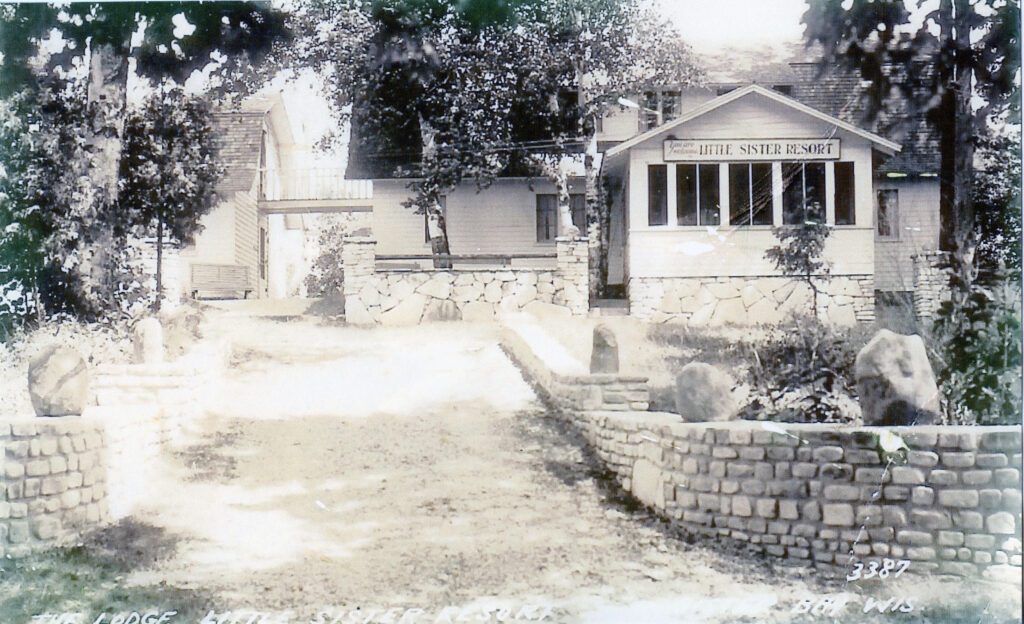
The beginnings of Little Sister Resort can be traced back to August 1865, when Endre Endreson and his 21-year old son Gunnar left Trondheim to escape compulsory military service in Norway. Gunnar’s sister had preceded them to America and was settled in Ephraim, Wisconsin, to which place they therefore naturally went.
Five years after arriving in America (1870), Gunnar, now spelling his name Gunder, bought 108 acres of wild timber land along the shores of Little Sister Bay. Having no cash to pay for the property, he contracted instead to furnish 550 bushels of potatoes over a period of three years. The contract had this stipulation with it: ‘All small and rotten potatoes to be picked out, and if the potatoes should fail, the deficiency to be paid in cash, at the rate of 75 cents per bushel’. At the time of the last payment at that rate, the Little Sister Resort property was bought for $412.50 in about 1874. Gunder’s signature on the contract was an ‘X’.
Each day, Gunder walked the three miles from his sister’s house to work on his land, clear space for a cabin, and build a pier where schooners could stop to haul his logs to Green Bay, Sturgeon Bay, and Chicago.
Another Anderson family settled not far from Gunder’s land. They were Swedes who had come to Chicago and then, after the Big Fire, to Door County. In that family, Gunder met his future wife, Emma.
Gunder and Emma reared ten children in their primitive home on the shores of Green Bay, taught them the Baptist Creed, and by example how to use resources at hand. Emma wove cloth for their clothes. They lived on fish, venison, bear meat, and a few grains and potatoes from the land Gunder was gradually clearing of trees and stumps. In the autumn, the children would pick beechnuts, butternuts, and wild berries. Gunder and Emma Anderson’s children married into families of other Norwegian and Swedish settlers.
One of their sons, Grant, settled at Little Sister and finally bought the property. From 1900 until after the first World War, Grant Anderson was engaged in commercial fishing. He and his brother paid for their first net in two years by furnishing a company in Marinette, Wisconsin, with 800 packages of salted fish, two hundred each spring and fall at the rate of $1.00 a package. Their season extended from May to the middle of June and from September until ice forced them to lift their nets. Their fishing rig consisted of a 25-foot sailboat, later replaced by a gasoline motorboat and a couple of skiffs, and many hundreds of feet of nets. They used the “pond net” method of fishing, then common in the bay. During the busy seasons of fishing, they kept as a man as ten men busy at the dressing bench in the fish house, salting the herring and packing it in one hundred pound wooden kegs called “packages”.
About 1911, the Anderson brothers sold the fishing business and Grant took over the management of the farm from his aging father, and gradually changed from grain farming to dairying. Early in the 20th century, travelers wishing to escape the summer heat of Chicago and other cities would ride up to the various docks in Door County via many of the Lake steamers, and either buy or seek a temporary place to enjoy this paradise for a while.
During the booming ‘Twenties’, wagon ruts became roads to accommodate the Reo’s, Pierce-Arrows, and Model T’s in transit. With the coming of the auto, the future of the Peninsula as a vacationland was secure. By 1918 the Anderson family (Grant had married a Swede, whose maiden name was Lydia Peterson) had started their resort business. They began by lodging and feeding a few guests at the farmhouse, Later, they build cabins for those who were asking for accommodations. Each year Grant, with his horse and buggy, met more guests at the piers in Sister Bay and Ephraim. Once they had tasted Mrs. Anderson’s juicy roasts and luscious cherry pies served with instructions to “eat as much as you want” and had lived in the unsophisticated comfort of a small cabin nestled under the pines, they joined the ranks of repeaters.
Grant’s grandsons, Winfield and Roland Anderson ran the resort from 1947 until 1973 when it sold. The new owners operated Little Sister Resort until 2020. It is the last of the old, original resorts in Sister Bay. Its closing after 102 years is the end of an era in Sister Bay’s history.
Cottage 18 – built in 1921
Cottage 17 – built in 1927 – remodeled to cottage 1968
Cottage 19 – built in 1924 – baths added in 1929
Cottage 20 – built in 1924
Cottage 21 – built in 1924 -3rd bedroom added 1949
Cottage 22 – built in 1933
Cottage 23 – built in 1933
Cottage 24 – built in 1947
Cottage 25 – built in 1960’s
Cottage 26 – built in 1960’s
Cottage 27 – built in 1960’s
Cottage 28 – built in 1960’s
Dining room and kitchen – built in 1921; additions later
Barn built in 1919
Chicken house built in 1918
Homestead was built about 1875
This history by provided and written by Martha Luber.


